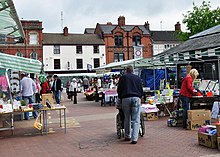Burton upon Trent
| Burton upon Trent | ||
|---|---|---|
| Coordinates | 52 ° 48 ′ N , 1 ° 39 ′ W | |
|
|
||
| Residents | 72,299 | |
| administration | ||
| Post town | BURTON-ON-TRENT | |
| ZIP code section | DE13-DE15 | |
| prefix | 01283 | |
| Part of the country | England | |
| region | West Midlands | |
| Shire county | Staffordshire | |
| District | East Staffordshire | |
| British Parliament | Burton | |

Burton upon Trent is a town on the River Trent in the east of the county Staffordshire in England. The city has 72,299 inhabitants (2011) and is the administrative seat of the East Staffordshire district .
history
Burton upon Trent emerged from a settlement around the monastery of St. Modwin. However, the city became known for its breweries , which were created due to the good quality of the water there. Burton is still home to several breweries today. A by-product of these breweries, both figuratively and literally, is a factory that makes marmite , a spread made from brewer's yeast . This in turn led to the production of Bovril , a salted yeast extract . Together with the breweries, these factories can give the area a distinctive smell.
From 1712 the River Trent was navigable from Hull, the North Sea port, to Burton. The beer was shipped on river barges to Hull and from there z. B. exported to the Baltic States, but also sold with coastal ships on the domestic markets in London or Edinburgh. Ultimately, the beer from Burton upon Trent found buyers throughout the British Empire .
With the opening of the Trent and Mersey Canal in 1777, transport was made easier and expanded, as it connected Liverpool on the west with Hull on the northeast coast of England.
The relatively slow ship transport did not damage the beer quality, and the transport costs were also moderate, because the shipowners liked to use the heavy oak barrels with beer as ballast in the lowest storage spaces below the ship's waterline. This was also advantageous for the transported beer because of the consistently cool temperature control.
However, the transport on the Trent and Mersey Canal also had its pitfalls: the narrowboats , the small inland vessels with a payload of just 30 tons, which were torn by horses, often got stuck in winter when the canal was e.g. T. was frozen over for weeks.
After around 60 years, the faster and more reliable railroad replaced the canal ships as the main means of transport from 1839.
When a ship loaded with India Pale Ale (a beer specially brewed for long journeys to India ) sank and barrels of this beer washed up, the taste of the local beer first changed. At the same time, a change in English beer taste began. Before that, the English mainly drank stout (best-known brand: Guinness ) and porter - dark beers that were spicy thanks to the use of roasted barley . As pale ale evolved into bitter , this heavily hopped light beer, which was easier to store and transport, became the beer of choice.
Burton dominated the trade in this type of beer; at the best of times, a quarter of the beer consumed in Britain came from the city. In 1880 there were more than 30 breweries, but through mergers and sales the number dropped to three by 1980. The pub operator Punch Taverns is headquartered in the city. In 1990 the first Poundland store opened in town.
Burton's notoriety for its beer led to the euphemistic saying Gone for a burton when someone died.
Sons of the city
- Sir Oswald Mosley, Bt. (1896–1980), founder of the British Union of Fascists
- Phil Seamen (1926–1972), drummer
- Philip Bond (actor) (1934-2017)
- David Nish (born 1947), football player
- Joe Jackson (born 1954), musician
- Ben Aucott (* 1970), racing car driver
- Paddy Considine (born 1973), actor
- Beth Rodford (born 1982), rower
- Peter Hickman (* 1987), motorcycle racer
- Martin Plowman (* 1987), racing car driver
Town twinning
-
 Lingen (Ems) in Lower Saxony
Lingen (Ems) in Lower Saxony -
 Bielawa in Poland
Bielawa in Poland
Individual evidence
- ^ The population development of Burton Upon Trent, Census 2011 citypopulation.de. Retrieved October 14, 2015

